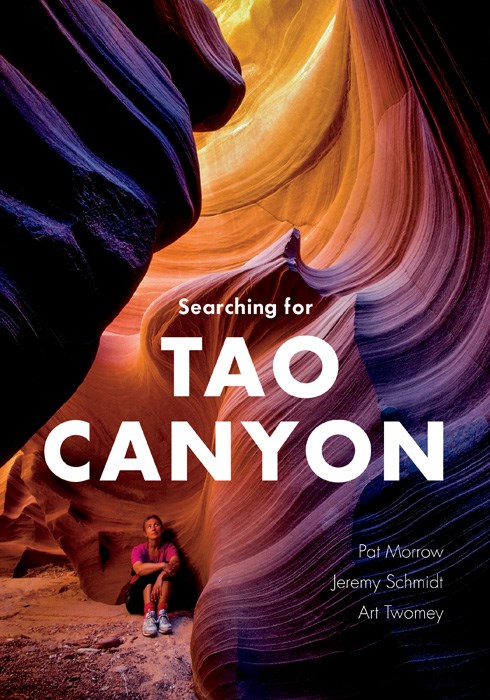Perhaps it was the same motivation that had attracted the ancient Anasazi civilization to live in the canyons in the first place.
Or, suggests adventure photojournalist Pat Morrow, it was something deeper, more mysterious that lured him and a small circle of friends and fellow photographers to return to the deep, narrow, intricately carved complex labyrinth of slot canyons concealed beneath the red rock floor of the Colorado Plateau four decades ago.
“From the instant I set foot in canyon country, I felt a spiritual connection,” Morrow said recently. “Who knows, maybe the countless signs of the now vanished Anasazi civilization that we discovered over the years provided us with the muse to photograph this unique landscape.”
The results are nothing short of mesmerizing and intoxicating.
Adding to the mystique, is the detail that all the images in Searching for Tao Canyon, newly published by Rocky Mountain Books, were captured on film, most of them on Kodachrome 25 – “not a digital one in the bunch.”
With the text written by Jackson Hole, Wyoming author Jeremy Schmidt, the images were taken by Morrow, a longtime Rockies resident now living and wandering in B.C.’s Purcell Mountains, and their close friend, the late Art Twomey.
“He was the original fun hog,” Schmidt and Morrow write, dedicating the book to their friend who died in a helicopter crash in 1997. “His passions mattered. Glaciologist, geologist, environmental activist (he was the main proponent of the Purcell Wilderness Conservancy, the largest of its kind in British Columbia), filmmaker, photographer, ski guide mountaineer, mule skinner and mentor.”
The book’s 184 pages comprise a thought-provoking, inspiring, touching and downright spectacular tribute.
In deep, rich tones of wheat, sand, mustard, gold, ochre, plum, eggplant purple and emerald green, the images that were made over 10 years beginning in 1975 stand the test of time – in some cases better than the exquisite canyons themselves.
In returning to some of their favourite canyons in the U.S. Southwest in recent years during the production of the book, Morrow and Schmidt discovered some of those places so delicately carved in sandstone by wind and water over millennia to now be well-travelled, crowded and noisy. As they did in magazine articles and books published at the time of their original explorations, Schmidt and Morrow have chosen in Searching for Tao Canyon not to name or provide directions to their mysterious, otherworldly subjects illuminated by dazzling, constantly shifting light.
“We have used pseudonyms for all the photos we’ve had published in magazines and other books over the years in an attempt to sensitize our audience to the delicate nature of these hidden places,” Morrow said. “I hope that those who visit the subterranean oases of the Colorado Plateau will seek the soul of the canyons and not just hunt for highly visible ‘selfie’ viewpoints.”
For Morrow, the canyons harbour extra special meaning, as he and his wife Baiba exchanged their wedding vows in one of their favourite canyons in 1984.
“Amongst our tiny entourage, which included co-author Jeremy Schmidt, was new age musician Paul Horn,” Morrow recalled. “We had listened to the music from his Inside the Taj Majal album for years and invited him to check out the acoustics. He played a little riff on his golden flute at the end of our simple ceremony.”
Publishing this gorgeous hardcover book four decades after their initial explorations of the then little-known natural wonders, Morrow said that reminding people of the fragility and pricelessness of the canyons is more urgent than ever.
“In the epilogue, we point out the public’s need to challenge the Trump administration’s shrinkage of Bears Ears National Monument to 16 per cent, and Grand Staircase-Escalante to a little over half of its original size,” Morrow said. “Some of the best canyons lie in an area that is now open to a potential mining and energy extraction bloodbath.”
Morrow and Schmidt will present Searching for Tao Canyon at the Banff Centre Mountain Film and Book Festival on Thursday, Nov. 1. For tickets or more information, visit www.banffcentre.ca/banff-mountain-film-book-festival.




